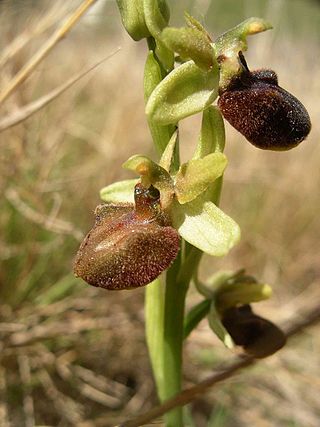Top Qs
Timeline
Chat
Perspective
Ophrys sphegodes
Species of flowering plant in the orchid family From Wikipedia, the free encyclopedia
Remove ads
Ophrys sphegodes, commonly known as the early spider-orchid,[2] is a species of sexually-deceptive orchid (through Pouyannian mimicry) native to Europe and the Middle East. It is a highly varied species with many subspecies recognised.
Remove ads
Description
Plant height varies with latitude. In the UK the maximum height is around 20 cm (8 in), but around the Mediterranean a height of 70 cm (28 in) may be reached.[3] Flowers March–May[3] (April–May in northern latitudes). Each shoot may carry between 2 and 18 flowers. The flowers have yellow-green sepals and a velvety red-brown labellum with a distinctive silvery-blue H marking so that the flowers much resemble an arthropod and especially a spider.
Similar to Ophrys fuciflora and Ophrys apifera but flowers differ in that late spider orchid and bee orchid have much smaller petals than sepals; in early spider orchid petals and sepals are a similar size. They are also distinguished by patches of colour on the labellum; late spider orchid has a yellow point at the centre of the distal end of the labellum, while bee orchid has a red patch at the proximal end of the labellum.
Remove ads
Distribution and habitat
Found on unimproved alkaline meadows, woodland edges,[3] as well as slopes, banks[4] and waste land. It is widespread across most of Europe and the middle East from Britain south to Portugal and east to Iran.[1]
In Britain, it is restricted to parts of Dorset, Hampshire, Kent and Sussex and is regarded as rare although where it is found it may be in stands of many hundreds of plants. It is classified as a British Red Data Book plant. Despite its apparent vulnerability, it has very successfully colonised the chalk spoil dumping grounds created near Dover at Samphire Hoe from the excavations of the Channel Tunnel. Worldwide, the IUCN conservation status of this species is least concern as of 2018.[5]
Remove ads
Ecology
In the UK Ophrys sphegodes is pollinated by the miner bee Andrena nigroaenea,[6] a polylectic pollinator (i.e. one that visits many different species of flower), a bee species which requires dry sandy soils.[7] Different subspecies have evolved to attract different pollinators.[3]
This orchid species is able to form symbiotic relationships with a range of species of mycorrhizal fungi.[8]
Taxonomy
Ophrys comes from the Ancient Greek for eyebrow, perhaps a reference to the velvety brown appearance of the labellum. Sphegodes comes from the Ancient Greek for wasp-like.[9][10] This species was formerly called O. aranifera, meaning spider-carrying.
The genus Ophrys is the most species-rich (i.e. diverse) genus of orchids in Europe and the Mediterranean with over 200 species, according to Orchids of Britain and Europe by Pierre Delforge.
Remove ads
Subspecies
Summarize
Perspective
Many subspecific and varietal names have been proposed. At the present time (May 2014), the following are recognized, one of them apparently originating as a hybrid between two of the others:[1]
- Ophrys sphegodes nothosubsp. jeanpertii (E.G.Camus) Del Prete & Conte – France, Spain, Balkans (O. sphegodes subsp. araneola × O. sphegodes subsp. sphegodes)
- Ophrys sphegodes subsp. aesculapii (Renz) Soó ex J.J.Wood – Greece
- Ophrys sphegodes subsp. araneola (Rchb.) M.Laínz – Germany, Switzerland, France, Spain, Italy, Yugoslavia
- Ophrys sphegodes subsp. atrata (Rchb.f.) A.Bolòs – from Portugal to Serbia
- Ophrys sphegodes subsp. aveyronensis J.J.Wood – France, Spain
- Ophrys sphegodes subsp. catalcana Kreutz – European Turkey
- Ophrys sphegodes subsp. cretensis H.Baumann & Künkele – Crete and other Greek islands
- Ophrys sphegodes subsp. epirotica (Renz) Gölz & H.R.Reinhard – Albania, Greece
- Ophrys sphegodes subsp. gortynia H.Baumann & Künkele – Crete and other Greek islands
- Ophrys sphegodes subsp. helenae (Renz) Soó & D.M.Moore – Albania, Greece
- Ophrys sphegodes subsp. mammosa (Desf.) Soó ex E.Nelson – from the Balkans to Turkmenistan
- Ophrys sphegodes subsp. melitensis (Nyman) E.Nelson – the Maltese islands
- Ophrys sphegodes subsp. passionis (Sennen) Sanz & Nuet – France, Spain, Sardinia, Sicily, mainland Italy
- Ophrys sphegodes subsp. sipontensis (R.Lorenz & Gembardt) H.A.Pedersen & Faurh. – Puglia
- Ophrys sphegodes subsp. sphegodes – from Britain and Spain to Hungary and the Balkans
- Ophrys sphegodes subsp. spruneri (Nyman) E.Nelson – Crete and other Greek islands
- Ophrys sphegodes subsp. taurica (Aggeenko) Soó ex Niketic & Djordjevic
- Ophrys sphegodes var. transhyrcana (Czerniak.) P.J.Cribb
Remove ads
Photo gallery
References
Wikiwand - on
Seamless Wikipedia browsing. On steroids.
Remove ads





